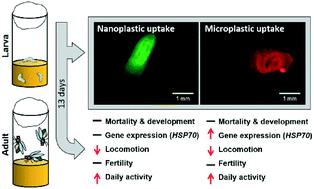当前位置:
X-MOL 学术
›
Environ. Sci.: Nano
›
论文详情
Our official English website, www.x-mol.net, welcomes your
feedback! (Note: you will need to create a separate account there.)
Polystyrene micro- and nanoplastics affect locomotion and daily activity of Drosophila melanogaster
Environmental Science: Nano ( IF 5.8 ) Pub Date : 2021-1-6 , DOI: 10.1039/d0en00942c Sara Matthews 1, 2, 3, 4 , Elvis Genbo Xu 5, 6, 7, 8 , Eva Roubeau Dumont 1, 2, 3, 4 , Victoria Meola 1, 2, 3, 4 , Oluwadamilola Pikuda 1, 2, 3, 4 , Rachel S. Cheong 1, 2, 3, 4 , Mingrui Guo 1, 2, 3, 4 , Rui Tahara 2, 3, 9, 10 , Hans C. E. Larsson 2, 3, 9, 10 , Nathalie Tufenkji 1, 2, 3, 4
Environmental Science: Nano ( IF 5.8 ) Pub Date : 2021-1-6 , DOI: 10.1039/d0en00942c Sara Matthews 1, 2, 3, 4 , Elvis Genbo Xu 5, 6, 7, 8 , Eva Roubeau Dumont 1, 2, 3, 4 , Victoria Meola 1, 2, 3, 4 , Oluwadamilola Pikuda 1, 2, 3, 4 , Rachel S. Cheong 1, 2, 3, 4 , Mingrui Guo 1, 2, 3, 4 , Rui Tahara 2, 3, 9, 10 , Hans C. E. Larsson 2, 3, 9, 10 , Nathalie Tufenkji 1, 2, 3, 4
Affiliation

|
Microplastics and nanoplastics are emerging contaminants in aquatic and terrestrial environments. Due to the challenges in detecting these small plastics in complex soil matrices, data about their abundance in terrestrial environments are scarce and our knowledge of their impacts on terrestrial organisms is severely lacking. Here, we introduced a well-established terrestrial model organism – the fruit fly (Drosophila melanogaster) – to study the chronic adverse effects of model micro- and nanoplastics. The toxicity of model dialyzed polystyrene spheres (1 μm and 20 nm) was assessed via dietary exposures to a wide range of concentrations (0.01 to 100 ppm). In a first experiment, flies were exposed from larval to adult stage for 13 days. Uptake of both particle sizes in the gastrointestinal tract of larvae was observed, with depuration times of 1 and 24 h for 20 nm and 1 μm particles, respectively. In adults, only 1 μm particles accumulated to detectable levels and nano computed tomography imaging revealed intestinal damage. Both micro- and nanoplastics significantly affected locomotion while mortality, development, and fertility were not significantly affected. A second 8 day experiment focused on the daily behavior of adults exposed to micro- and nanoplastics. We observed no effect on circadian rhythms but an increase in daily activity after micro- and nanoplastic exposure at 50 ppm, likely in response to a reduction in nutrient absorption due to the change in diet or intestinal damage. Overall, dietary exposures to clean spherical polystyrene micro- and nanoplastics caused low toxicity but significant sublethal effects in the fruit fly. This study establishes a baseline understanding of the impacts of model micro- and nanoplastic exposure to the fruit fly and motivates the need for further work focusing on naturally weathered plastic debris.
中文翻译:

聚苯乙烯微塑料和纳米塑料会影响果蝇的运动和日常活动
微塑料和纳米塑料是在水生和陆地环境中新兴的污染物。由于在复杂的土壤基质中检测这些小塑料存在挑战,因此缺乏有关其在陆地环境中的丰度的数据,而且我们对它们对陆地生物的影响的认识也十分缺乏。在这里,我们介绍了一种建立良好的陆地模型生物-果蝇(Drosophila melanogaster),以研究模型微塑料和纳米塑料的长期不利影响。通过以下方法评估了模型透析的聚苯乙烯球(1μm和20 nm)的毒性:饮食中的浓度范围很广(0.01至100 ppm)。在第一个实验中,果蝇从幼虫到成年阶段暴露了13天。观察到幼虫在胃肠道中均吸收了两种粒径,对于20 nm和1μm颗粒,净化时间分别为1和24 h。在成年人中,只有1μm颗粒积累到可检测的水平,并且纳米计算机断层扫描显像显示肠道损伤。微米塑料和纳米塑料都显着影响运动,而死亡率,发育和生育力未显着影响。第二个为期8天的实验着重于暴露于微米和纳米塑料的成年人的日常行为。我们观察到对生物钟节律没有影响,但是在50 ppm的微塑料和纳米塑料暴露后,每日活动增加,可能是由于饮食变化或肠道损害导致营养吸收减少所致。总体而言,饮食中接触清洁的球形聚苯乙烯微米和纳米塑料会导致低毒,但对果蝇具有显着的亚致死作用。这项研究建立了对模型微和纳米塑料暴露于果蝇的影响的基线理解,并激发了针对自然风化的塑料碎片开展进一步工作的需求。
更新日期:2021-01-06
中文翻译:

聚苯乙烯微塑料和纳米塑料会影响果蝇的运动和日常活动
微塑料和纳米塑料是在水生和陆地环境中新兴的污染物。由于在复杂的土壤基质中检测这些小塑料存在挑战,因此缺乏有关其在陆地环境中的丰度的数据,而且我们对它们对陆地生物的影响的认识也十分缺乏。在这里,我们介绍了一种建立良好的陆地模型生物-果蝇(Drosophila melanogaster),以研究模型微塑料和纳米塑料的长期不利影响。通过以下方法评估了模型透析的聚苯乙烯球(1μm和20 nm)的毒性:饮食中的浓度范围很广(0.01至100 ppm)。在第一个实验中,果蝇从幼虫到成年阶段暴露了13天。观察到幼虫在胃肠道中均吸收了两种粒径,对于20 nm和1μm颗粒,净化时间分别为1和24 h。在成年人中,只有1μm颗粒积累到可检测的水平,并且纳米计算机断层扫描显像显示肠道损伤。微米塑料和纳米塑料都显着影响运动,而死亡率,发育和生育力未显着影响。第二个为期8天的实验着重于暴露于微米和纳米塑料的成年人的日常行为。我们观察到对生物钟节律没有影响,但是在50 ppm的微塑料和纳米塑料暴露后,每日活动增加,可能是由于饮食变化或肠道损害导致营养吸收减少所致。总体而言,饮食中接触清洁的球形聚苯乙烯微米和纳米塑料会导致低毒,但对果蝇具有显着的亚致死作用。这项研究建立了对模型微和纳米塑料暴露于果蝇的影响的基线理解,并激发了针对自然风化的塑料碎片开展进一步工作的需求。











































 京公网安备 11010802027423号
京公网安备 11010802027423号